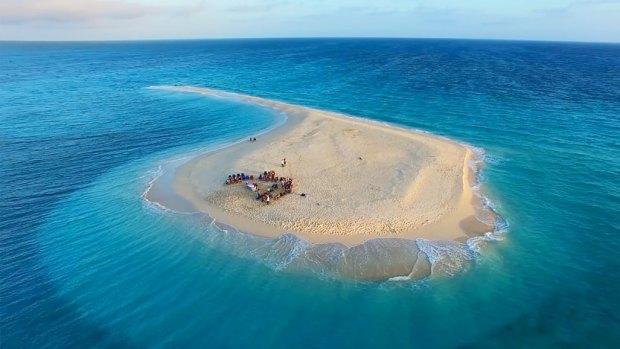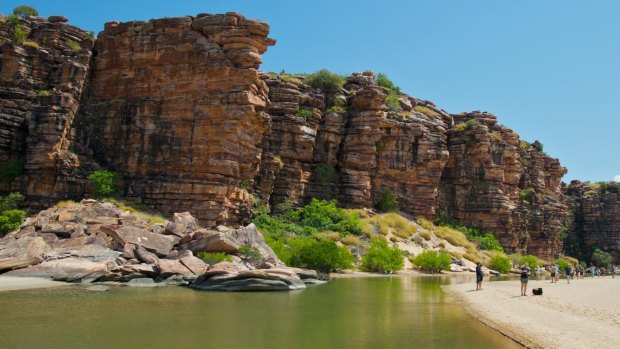By Mal Chenu
This is sponsored content for Coral Expeditions.
When it comes to cruising, the salt air, exotic ports and relaxation all get big ticks. But then there are the crowds. Sharing a noisy, floating metropolis with thousands of other people is not everyone's cup of tea, or cocktail-filled coconut with a paper parasol and swizzle stick. But what if you could keep all the romance of an adventure at sea and replace the crowds with intimate, personal service and explorations of tiny islands that are off-limits to bigger ships?
Small ship expedition cruising is the fastest growing sector in the booming cruise market. It is built around detailed planning and providing guests with the ultimate experience; connecting them to cultures, communities and pristine natural habitats that are only accessible by sea. Destination is everything. And everywhere you stop, it's crowd-free. No queues to disembark, no crowded ports, no teeming marketplaces knocking out the same souvenirs and no sightseers climbing all over you to get a better angle for their selfie-sticks.

Guests enjoy sunset drinks on Sudbury Cay, Great Barrier Reef.
Coral Expeditions has been a leader in the small cruise space for decades. The Australian company operates four ships, ranging in capacity from 42 aboard Coral Expeditions II to 120 aboard the soon-to-be-launched luxury Coral Adventurer, which will cruise to The Kimberley, Papua New Guinea and the islands of Indonesia. These are Goldilocks ships; not too big and not too small.
They are big enough to comfortably tackle the open sea, and small enough to land guests quickly and easily on secluded beaches in Tasmania or Papua New Guinea or anchor over magnificent snorkeler-friendly coral forests on the Great Barrier Reef or Indonesia's Spice Islands (the Moluccas).

Marvel at remote Koolama Bay in the Kimberley
They are big enough to provide spacious, comfortable cabins and suites, and small enough to remember your drink of choice. Big enough to ensure there is always something interesting to do, and small enough to find a spot on the sundeck or in a quiet lounge to read or relax.
Big enough to thrill, small enough to chill.
Coral Expeditions' fleet of small cruise ships use tenders and zodiacs to gain access to memorable, hard-to-reach places. Each ship is equipped with a clever hydraulic system that launches tender vessels into the water. Guests walk straight off the deck on to the tenders and are out and exploring in just minutes.
As the Senior Master with Coral Expeditions, Gary Wilson, puts it:
"The tenders are one the best features of our fleet and give our expeditions a unique edge. We can wriggle into tight spots and land passengers in places no one else goes. For example, on a recent trip to the island of Kasiruta in the Spice Islands, we went to a little village that had never had a ship visit before. The whole village turned out to welcome us. The kids were really excited, there were dances and speeches, food was shared; it was just great. We anchored overnight in a tiny bay that felt like the middle of nowhere. These sorts of experiences are really special and we wouldn't be able to do them without our unique landing vessels."
Passengers on expeditionary cruises bond over adventures like this. You chat about past journeys and future plans. Strangers become friends. Dinners that were quiet, polite affairs at the beginning of the cruise become fun, raucous parties by the end. It's like a floating lodge you take with you to a new adventure every day. Wilson says the mix of people creates this camaraderie.
"I think one thing that sets small ship cruising apart is the groups we get on board. They're like-minded people who have done their research. They know what they want to see and do and they want to get the most out of each day. Over the course of the cruise, the ship becomes a big family. At the end we often see tears and hugs for the crew. You just don't get that sort of feel on larger ships."
Coral Expeditions has an open-bridge policy, which means if the door is open – and it usually is - you are free to wander in and have a chat to the captain and crew. They might not let you steer through tight passages but you can pore over the charts, talk navigation and get up close and personal with the pointy end of the operation. Try doing that on a mega-tonne cruise liner!
"Open bridge is a big part of what we do. It's very popular and passengers love it. We have a lounge up there, they can see what's going on and we are always keen for a chat!" says Wilson.
Coral Expeditions take expert guides and guest lecturers along for the ride too. These highly-educated and experienced specialists are also garrulous raconteurs, so in addition to absorbing lectures on the ship and illuminating guided excursions on land, you're very likely to find yourself immersed in a fascinating conversation over a sunset drink or at dinner.
For over 30 years, Coral Expeditions has had one purpose – to take small groups of explorers to remote parts of the world with expert guidance and warm Australian hospitality. Australian flagged and crewed, Coral Expeditions provides the highest standard of service, environmental responsibility and the intimate and personal experience of small ship cruising. Our expedition cruises bring you closer to history, culture, pristine coastlines, and wildlife in our remote destinations: The Kimberley, Cape York & Arnhem Land, Tasmania, the Great Barrier Reef, Papua New Guinea, the South Pacific, New Zealand, and the Indonesian Archipelago.
Sign up for the Traveller Deals newsletter
Get exclusive travel deals delivered straight to your inbox. Sign up now.